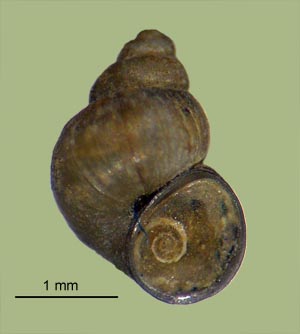> Habitat & Distribution
Floridobia floridana has been recorded from artesian wells on Cumberland Island, in the extreme southeastern corner of Georgia. The species becomes much more common further south, according to Thompson (1968), from the Suwanee River to Orlando and Hillsborough County, although we have no records. It inhabits sloughs, ponds, ditches, lakes, springs, and streams with variable current. Floridobia floridana is pseudo-rare in US Atlantic drainages, FWGNA incidence rank I-1p.
We are also aware of at least two (apparently undescribed) Floridobia species inhabiting Atlantic drainages further north. See separate pages for Floridobia Species A from Georgia's Ogeechee River and the Waccamaw Floridobia of North Carolina.
> Ecology & Life History
No specific life history data are as yet available for Floridobia. The largest populations of F. floridana encountered by Thompson (1968) were in springs and spring runs with clear water where vegetation is abundant. Individuals are usually found on aquatic plants, especially rooted forms, but occasionally forage on sand, gravel, rock, and silt, especially if algae and diatoms are abundant (Thompson 1968).
Hydrobioids seem to be rather nonspecific grazers of small particles (Dillon 2000: 94-97). The laboratory feeding experiments of Schultheis & Kellmann (2013) showed that a mixed diet of the yellow-green filamentous Vaucheria and the blue-green filamentous Lyngbya was superior to either alga in pure diet.
Hydrobioids are (almost) universally dioecious, the males being characterized by a penis that arises from the neck. Females attach single eggs in spare, hemispherical capsules to solid substrates (Hershler 1994).
> Taxonomy & Systematics
Like Spilochlamys, Notogillia, and Marstonia, the genus Floridobia belongs to the subfamily Nymphophilinae of the Hydrobiidae (ss), males being characterized by a lobe-shaped penis (or verge) with surficial glandular patterns. The Floridobia penis has crescent-shaped terminal and ventral glands on its large terminal penial lobe and a slender flagellum (Kabat and Hershler 1993, Thompson 1968, 2004).
The genus Floridobia has only recently been distinguished from Cincinnatia, on the basis of female reproductive anatomy (Thompson & Hershler 2002). Interestingly, the mtDNA survey of Hershler et al. (2003) revealed little differentiation between Floridobia and the (primarily western) hydrobiid genus Pyrgulopsis. The difference between Floridobia and Marstonia seems to be more pronounced.
A Floridobia floridana sequence also made a cameo appearance (as an outgroup) in the western study of Liu & Hershler (2005).
> Maps and Supplementary Resources
- Floridobia distribution in Atlantic drainages (2023)
- Floridobia distribution in Georgia and the Florida panhandle (2025)
> Essays
- Earlier versions of this website, online until August of 2016, adopted the large, broadly-inclusive concept of the Hydrobiidae (sl) following Kabat & Hershler (1993). More recently the FWGNA project has shifted to the Wilke et al. (2013) classification system, distinguishing a much smaller Hydrobiidae (ss) and elevating many hydrobioid taxa previously ranked as subfamilies to the full family level. For more details, see The Classification of the Hydrobioids.
> References
Dillon, R. T., Jr. (2000) The Ecology of Freshwater Molluscs. Cambridge, Cambridge University Press. 509 pp.
Hershler, R. (1994) A review of the North American freshwater snail genus Pyrgulopsis (Hydrobiidae). Smithsonian Contributions to Zoology 1994; 0(554):1-115.
Hershler, R., H. Liu, and F.G. Thompson (2003) Phylogenetic relationships of North American nymphophiline gastropods based on mitochondrial DNA sequences. Zoologica Scripta 32:357-366.
Kabat, A.R., and R. Hershler (1993) The prosobranch snail family Hydrobiidae (Gastropoda: Rissooidea): review of classification and supraspecific taxa. Smithsonian Contributions to Zoology 547:1-94.
Liu, H., and R. Hershler (2005) Molecular systematics and radiation of western North American nympholine gastropods. Molecular Phylogenetics and Evolution 34:284-298.
Schultheis, A. S. & C. R. Kellmann (2013) Cyanobacteria-rich diet reduces growth rates of the hyacinth siltsnail Floridobia floridana (Gastropoda: Hydrobiidae) Walkerana 16: 1 - 8.
Thompson, F.G. (1968) The Aquatic Snails of the Family Hydrobiidae of Peninsular Florida. University of Florida Press, Gainesville, Florida, USA.
Thompson, F.G. (2004) An identification manual for the freshwater snails of Florida.
Thompson, F. G. & R. Hershler (2002) Two genera of North American freshwater snails: Marstonia Baker, 1926, resurrected to generic status, and Floridobia, new genus (Prosobranchia: Hydrobiidae: Nymphophilinae). The Veliger 45: 269 - 271.
Wilke T., Haase M., Hershler R., Liu H-P., Misof B., Ponder W. (2013) Pushing short DNA fragments to the limit: Phylogenetic relationships of hydrobioid gastropods (Caenogastropoda: Rissooidea). Molecular Phylogenetics and Evolution 66: 715 736.








